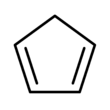| |||

| |||
| Names | |||
|---|---|---|---|
| Preferred IUPAC name
Cyclopenta-1,3-diene | |||
| Other names | |||
| Identifiers | |||
3D model (JSmol)
|
|||
| Abbreviations | CPD, HCp | ||
| 471171 | |||
| ChEBI | |||
| ChemSpider | |||
| ECHA InfoCard | 100.008.033 | ||
| EC Number |
| ||
| 1311 | |||
| MeSH | 1,3-cyclopentadiene | ||
PubChem CID
|
|||
| RTECS number |
| ||
| UNII | |||
CompTox Dashboard (EPA)
|
|||
| |||
| |||
| Properties | |||
| C5H6 | |||
| Molar mass | 66.103 g·mol−1 | ||
| Appearance | Colourless liquid | ||
| Odor | irritating, terpene-like[1] | ||
| Density | 0.802 g/cm3 | ||
| Melting point | −90 °C; −130 °F; 183 K | ||
| Boiling point | 39 to 43 °C; 102 to 109 °F; 312 to 316 K | ||
| insoluble[1] | |||
| Vapor pressure | 400 mmHg (53 kPa)[1] | ||
| Acidity (pKa) | 16 | ||
| Conjugate base | Cyclopentadienyl anion | ||
| −44.5×10−6 cm3/mol | |||
Refractive index (nD)
|
1.44 (at 20 °C)[3] | ||
| Structure | |||
| Planar[4] | |||
| 0.419 D[3] | |||
| Thermochemistry | |||
Heat capacity (C)
|
115.3 J/(mol·K) | ||
Std molar
entropy (S⦵298) |
182.7 J/(mol·K) | ||
Std enthalpy of
formation (ΔfH⦵298) |
105.9 kJ/mol[3] | ||
| Hazards | |||
| NFPA 704 (fire diamond) | |||
| Flash point | 25 °C (77 °F; 298 K) | ||
| 640 °C (1,184 °F; 913 K) | |||
| Lethal dose or concentration (LD, LC): | |||
LC50 (median concentration)
|
14,182 ppm (rat, 2 h) 5091 ppm (mouse, 2 h)[5] | ||
| NIOSH (US health exposure limits): | |||
PEL (Permissible)
|
TWA 75 ppm (200 mg/m3)[1] | ||
REL (Recommended)
|
TWA 75 ppm (200 mg/m3)[1] | ||
IDLH (Immediate danger)
|
750 ppm[1] | ||
| Related compounds | |||
Related hydrocarbons
|
Benzene Cyclobutadiene Cyclopentene | ||
Related compounds
|
Dicyclopentadiene | ||
Except where otherwise noted, data are given for materials in their standard state (at 25 °C [77 °F], 100 kPa).
| |||
Cyclopentadiene is an organic compound with the formula C5H6.[6] It is often abbreviated CpH because the cyclopentadienyl anion is abbreviated Cp−.
This colorless liquid has a strong and unpleasant odor. At room temperature, this cyclic diene dimerizes over the course of hours to give dicyclopentadiene via a Diels–Alder reaction. This dimer can be restored by heating to give the monomer.
The compound is mainly used for the production of cyclopentene and its derivatives. It is popularly used as a precursor to the cyclopentadienyl anion (Cp−), an important ligand in cyclopentadienyl complexes in organometallic chemistry.[7]
- ^ a b c d e f g NIOSH Pocket Guide to Chemical Hazards. "#0170". National Institute for Occupational Safety and Health (NIOSH).
- ^ William M. Haynes (2016). CRC Handbook of Chemistry and Physics [Physical Constants of Organic Compounds]. Vol. 97. CRC Press/Taylor and Francis. p. 276 (3-138). ISBN 978-1498754286.
- ^ a b c William M. Haynes; David R. Lide; Thomas J. Bruno, eds. (2016). CRC handbook of chemistry and physics : a ready-reference book of chemical and physical data (2016-2017, 97th ed.). Boca Raton, Florida: CRC Press. ISBN 978-1-4987-5428-6. OCLC 930681942.
- ^ Faustov, Valery I.; Egorov, Mikhail P.; Nefedov, Oleg M.; Molin, Yuri N. (2000). "Ab initio G2 and DFT calculations on electron affinity of cyclopentadiene, silole, germole and their 2,3,4,5-tetraphenyl substituted analogs: structure, stability and EPR parameters of the radical anions". Phys. Chem. Chem. Phys. 2 (19): 4293–4297. Bibcode:2000PCCP....2.4293F. doi:10.1039/b005247g.
- ^ "Cyclopentadiene". Immediately Dangerous to Life or Health Concentrations (IDLH). National Institute for Occupational Safety and Health (NIOSH).
- ^ LeRoy H. Scharpen and Victor W. Laurie (1965): "Structure of cyclopentadiene". The Journal of Chemical Physics, volume 43, issue 8, pages 2765–2766. doi:10.1063/1.1697207.
- ^ Hartwig, J. F. (2010). Organotransition Metal Chemistry: From Bonding to Catalysis. New York, NY: University Science Books. ISBN 978-1-891389-53-5.


